Aquariums without soil substrates and with bare-bottomed tanks have become increasingly popular in recent years. The trend, which was started by the Dutch and the Germans, has since gained widespread popularity across the world. However, many hobbyists wonder if the lack of substrate means that they will be stuck with plastic plants in the way of plant decor.
If this describes your predicament, we have some good news for you! There are many types of aquarium plants that will do just fine without aquatic substrate. These plants absorb the necessary nutrients from the water column via their roots, and will therefore thrive if they are properly fertilized. To learn more about these plants, please read on!
15 Aquarium Plants That Can Thrive Without Substrate
Growing freshwater aquatic plants without substrates poses a fun challenge. It is a lot harder in some ways, because you have to rely on inorganic nutrients from the water column. This means that you will need to fertilize your plants regularly. Luckily, there are many types of aquarium plants that do not need substrate to survive!
To set you up for success, we have compiled a list of 15 common freshwater aquarium plants that can thrive in a bare tank. Many of the plants listed below also serve as great beginner plants, so rest assured that you will be able to grow them easily!
Hornwort

Scientific Name: Ceratophyllum demersum
Growth Rate: Moderate to Fast
Lighting: Moderate to High
Temperature: 40ºF-77ºF
Hornwort is by far one of the easiest plants to grow in the aquarium. It looks great when planted, doesn’t require any substrate, and has a very nice light green color. In fact, it’s so easy to grow that you can have a full bush in just a few days from cutting it from another tank!
To help your Hornwort thrive without a substrate, you will want to make sure that your tank is equipped with a powerhead, as the plant requires very strong currents. It’s also a good idea to fertilize with root tabs on a weekly basis to ensure optimal growth.
You can also let the Hornwort float at the top of the aquarium. Doing so will allow it to provide cover for fish fry, and will make it easier to care for. Just make sure that your tank is covered (very important), as the rapid growth of hornwort may make it a safety hazard.
Java Moss

Scientific Name: Taxiphyllum barbieri
Growth Rate: Moderate
Lighting: Low to Moderate
Temperature: 68ºF-79ºF
Java Moss is yet another plant that doesn’t require a substrate. It can be grown on nearly any surface, including the wall of your aquarium. It’s a slow grower and can be easily trimmed to keep it looking its best. You can also opt to leave it untrimmed for a more natural look.
Since this plant doesn’t have a root system, you’ll want to ensure that it has something to grab onto before planting it in your tank. A piece of driftwood or rock should do just fine. The Java Moss is very easy to care for and makes a great addition to any aquarium.
To top it all off, this popular aquarium plant has a very unique look to it, with green leaves that are soft and Velcro-like. Baby fish and fish species such as bettas and guppies tend to love tanks that contain Java Moss, as they often enjoy hiding in the nooks and crannies of driftwood or other decorations.
Java Fern
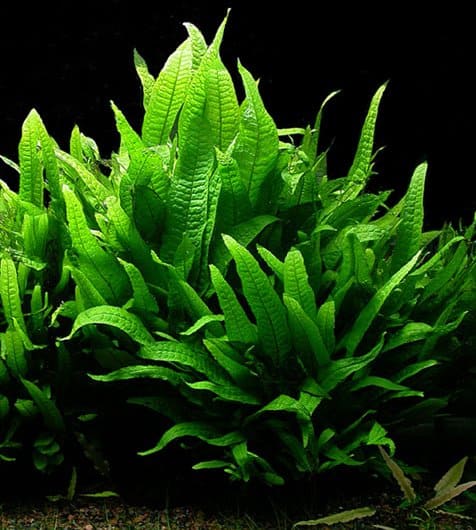
Scientific Name: Microsorum pteropus
Growth Rate: Moderate to Fast
Lighting: Low to Moderate
Temperature: 68ºF-82ºF
Java Fern is a fan favorite for many aquarists. It’s a relatively slow grower, but is known for being a hardy plant that will eventually spread across the tank if given enough time and light. To grow it without a substrate, you’ll need to tie it onto driftwood with string. Rocks or other decorations in your tank will also work as an alternative surface.
To keep this plant healthy, liquid fertilizer should be added on a weekly basis to ensure proper growth and promote root development. Make sure that your Java fern receives sufficient nutrients and the correct nutrient balance by opting for aquarium plant food that is specially formulated for floating plants.
Java Fern is also a very popular option for aquascaping, particularly for hobbyists who face tank size constraints. Its slow growth means that it will stay out of the way of most fish, and its delicate leaves blend into the background very nicely.
Anubias
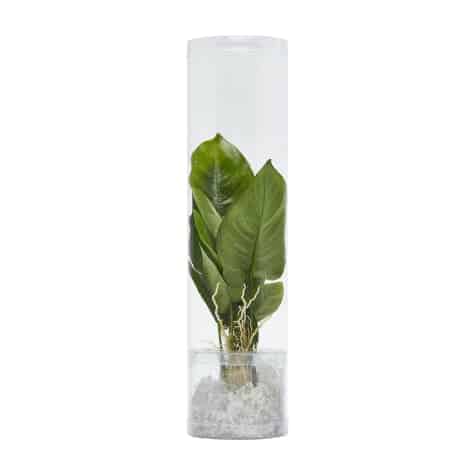
Scientific Name: Anubias nana
Growth Rate: Moderate
Lighting: Low to Moderate
Temperature: 73ºF-82ºF
Anubias plants are another favorite of many aquarists, as they are known for being very hardy and long-lived. This plant is also one that will do well without substrate. As the anubias is a slow grower and requires low lighting (particularly in the beginning) It is an excellent choice for those hobbyists who want to keep their tank looking natural and do not own high-powered lights.
You can also let anubias float on top of your aquarium as it grows, as long as you provide it with moderate lighting and fertilizer. However, it will eventually grow roots, so it should be planted on a substrate or attached to driftwood with a fishing line at some point. The larger it grows, the bigger your fish tank will need to be.
The Anubias species is also an excellent choice for fish who are not big fans of plants. It has a low profile and provides cover for shy fish who seek a hiding spot from more aggressive fish. It also has spiky leaves that larger species tend to avoid (for the most part).
Water Lettuce
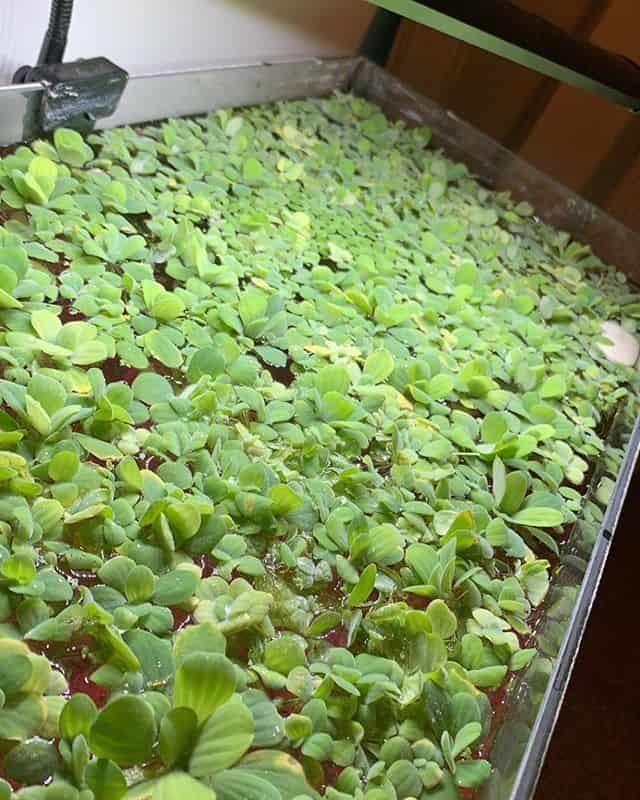
Scientific Name: Pistia stratiotes
Growth Rate: Fast
Lighting: Low
Temperature: 72ºF-82ºF
Water Lettuce (Pistia) is a popular aquatic plant due to its unique texture and look. This fast-growing plant is perfect for larger tanks as its broad leaves provide excellent cover for fish who enjoy swimming among plants. Though it can be grown on aquarium substrate, many people prefer to use it as a floating plant because of its attractive leaf shape.
Water lettuce propagates through fragmented stems that let out roots and shoots at their nodes. You can cut off smaller leaves from its parent plant or harvest baby plants and replant them elsewhere in your tank. However, letting the loose leaves of this beautiful plant float around your tank will lend it a charm of its own.
The pistia stratiotes is capable of growing in a wide range of water parameters, but prefers ideal conditions of a pH of 7.2-7.5, moderate water hardness, and a temperature range of 72ºF to 82ºF. It can be grown in low lighting conditions, but will grow much faster when exposed to higher levels of light (ideally 6500K).
Green Cabomba
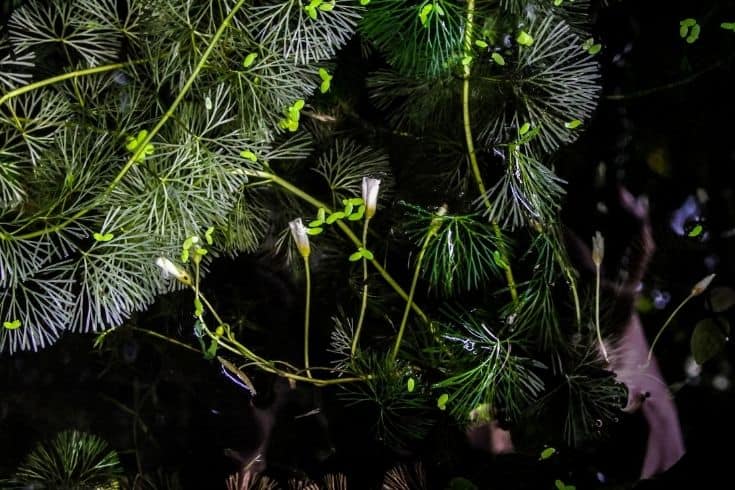
Scientific Name: Cabomba caroliniana
Growth Rate: Moderate to Fast
Lighting: Low to High
Temperature: 72ºF – 82º
Green Cabomba, also known as Carolina Fanwort, is popular for many different reasons. It provides a lovely base for your larger species of fish or to add highlights in your tank when planted into substrate. It grows fast, but does well in low light conditions and will thrive when exposed to moderate levels of light.
The Green Cambomba is often used as an accent or light cover plant because of its delicate, lacy texture that grows into dense patches. It can also grow quite tall (18″) and will provide plenty of cover for larger fishes like oscars, tangs, and other herbivorous fish who appreciate a little hiding place.
Adaptable as the Green Cabomba may be, it should be grown in clean water conditions with a moderate to high pH, hardness, and temperature. The ideal lighting for the Cabomba is moderate to high lighting with no shading. It can be grown well in both freshwater and brackish water conditions.
Anacharis

Scientific Name: Elodea Densa
Growth Rate: Moderate
Lighting: Low
Temperature: 50ºF – 80ºF
Anacharis, also known as Anacharis or Caelenadian Elodea has bright green leaves make it a hit with seasoned fishkeepers and beginners alike. It grows relatively fast and can under low to medium lighting. A common freshwater aquarium light setup will be enough to provide it with the moderate lighting it needs.
The elodea densa can be grown via substrate planting but will do well when floated in your aquarium instead. It is capable of storing large amounts of nutrients from the water column, which is good because this makes it an easy-care plant. However, the silicates stored can cause algae buildup if not cleaned out on a regular basis.
In addition, the Elodea is very sensitive to changes in ammonia levels and pristine water quality. Though this is not a difficult plant by any means, it does require that you keep your tank water clean. Be sure to change your water frequently and remove dead leaves to keep your anacharis healthy.
Duckweed
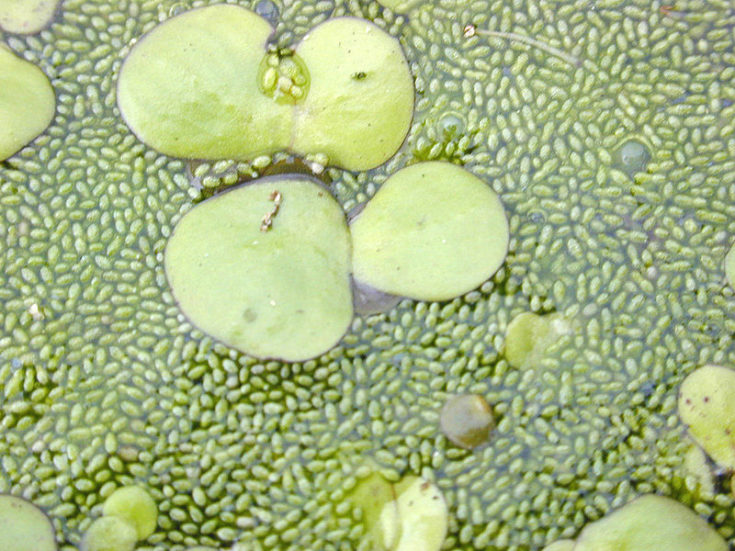
Scientific Name: Lemna minor
Growth Rate: Fast
Lighting: Low to Moderate
Temperature: 50ºF – 82ºF
Among the many freshwater aquarium plants on this list, duckweed is unique in that it can grow in a wide range of water parameters. Many hobbyists opt to place duckweed in aquariums housing discus and dwarf cichlids because of how easy it is to care for. You don’t need a strong light source, nor do you need a high-tech setup to help it thrive.
While duckweed may grow in a wide range of water parameters, it does prefer clean and pristine conditions so as not to promote algae growth on its broad leaves. It can be grown by just placing the plant directly onto any aquarium water surface. Duckweed also has minimal true roots, so maintenance will be a breeze.
Just remember, this hardy little thing will grow quickly which makes it easy to over-plant your tank. If you plan on planting duckweed, monitor its growth closely and remove excess plants to prevent it from overcrowding your aquarium. This will ensure that your other plants get the appropriate hours of light they need to thrive.
Amazon Frogbit

Scientific Name: Limnobium laevigatum
Growth Rate: Fast
Lighting: Low to Moderate
Temperature: 50ºF – 80ºF
Amazon frogbit is a very versatile species capable of growing well in most tanks. It can be grown both submersed and emersed depending on how much light per gallon of water your tank receives. If you intend to keep it emersed, provide it with lots of light to keep healthy.
One giant benefit of keeping amazon frogbit is its amazing ability to keep algae in check. These plants control algae growth by depleting nutrients in the water column. They do so at a faster rate than other freshwater aquarium plants, allowing them to out-compete algae and deprive them of sufficient nutrients.
Nutrient buildup, however, is still a problem with these plants. Provide them with proper care by rinsing out their leaves with a turkey baster or siphon as stray food particles can cause a dirty tank. Also, monitor your water’s nutrient levels closely as this plant can be used to test for high potassium or phosphates because it will die off in those conditions.
Floating Crystalwort
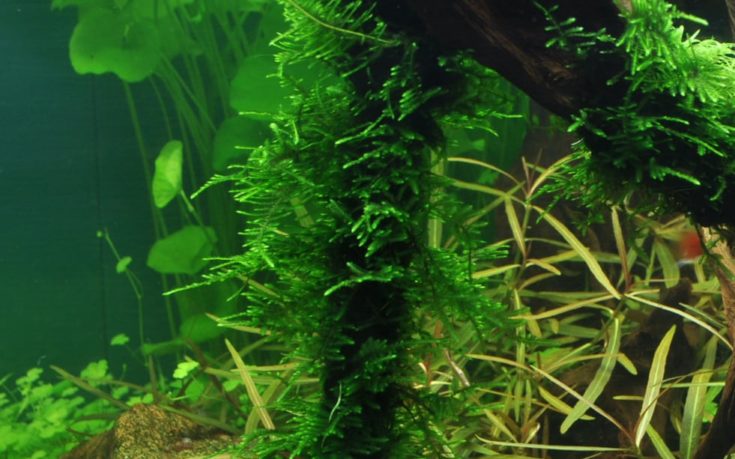
Scientific Name: Riccia fluitans
Growth Rate: Moderate
Lighting: Low to Moderate
Temperature: 50ºF – 80ºF
Riccia fluitans is a very different freshwater aquarium plant when compared to others on this list. It does not grow in the traditional sense. Riccia fluitans floats on water surfaces, producing runners that attach to hardscape or other objects. It has no true leaves but instead will form a mat of green stems and thin roots.
Algae growth can be controlled in part by riccia fluitans. It is shallow-rooted, so it cannot remove nutrients from the water column like species with large root systems. Instead, it physically blocks light from reaching algae-feeding plants below when present at high densities.
If you plan on keeping riccia, be sure to provide it with ample lighting in the form of a power strip or desk lamp. These plants don’t need bright light, but they do require some essential light, or they will likely turn brown and die off. Adding carbon dioxide to your tank can help ensure its success because riccia grows even better when CO2 is present.
Brazilian Pennywort

Scientific Name: Hydrocotyle leucocephala
Growth Rate: Moderate
Lighting: Low to Moderate
Temperature: 50ºF – 80ºF
Brazilian pennywort is an emersed plant capable of forming dense mats on the water’s surface. It does not produce runners but has small, white roots. These roots are perfect for attaching to driftwood or rocks, allowing you to attach it in any hardscape that will stay submerged.
Brazilian pennywort is an excellent choice for low- to moderate-light aquariums thanks to its unique leaf shape. Rather than being flat like other plants on this list, Brazilian pennywort’s leaves are round and cupped. These leaves are the perfect size for most aquariums, covering up unsightly substrate.
These plants grow well in both hard and soft water but do best in warmer conditions ranging from 70 °F to 80 °F. While they prefer acidic water, pennywort isn’t very particular about its pH levels and will grow fine in neutral or slightly alkaline tanks.
Indian Toothcup
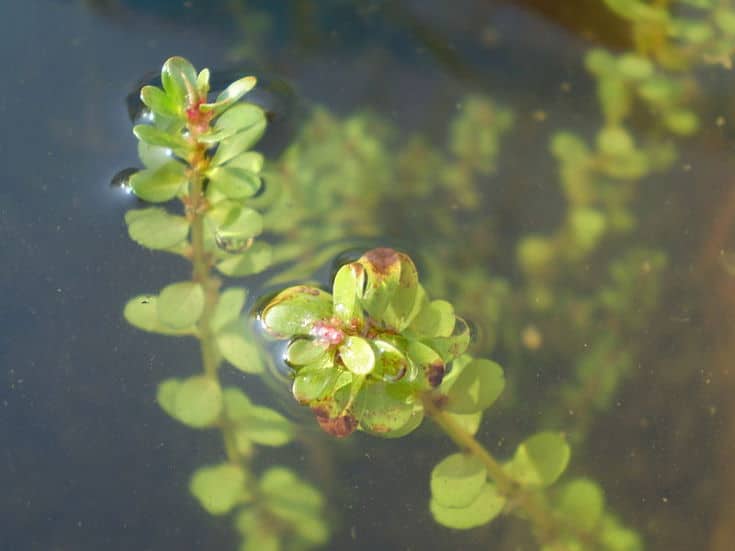
Scientific Name: Rotala indica
Growth Rate: Slow to Moderate
Lighting: Low to Moderate
Temperature: 50ºF – 80ºF
The Indian Toothcup is a low-growing, carpeting plant that you can grow in your freshwater aquarium. Its leaves are narrow and create dense coverage on the water’s surface. The rotala indica also has no roots and is difficult to attach to a hardscape, but you can tie it to other plants or driftwood with a fishing line if necessary.
Rotala indica should be pre-soaked for an hour before being added to your aquarium because it needs time to adjust before introducing the proper nutrients into its system. Like Brazilian pennywort, Rotala indica is very sensitive to the pH of its water. It will grow well in slightly acidic or neutral conditions but cannot tolerate alkaline levels.
In terms of plant growth, Rotala indica is considered a slow grower. It will not cause algae problems in your aquarium, nor does it produce runners that can clog up your tank’s filtration system. The Indian toothcup is best for low-light conditions and can even survive better in dim lighting than it can in bright artificial light.
Creeping Primrose-Willow
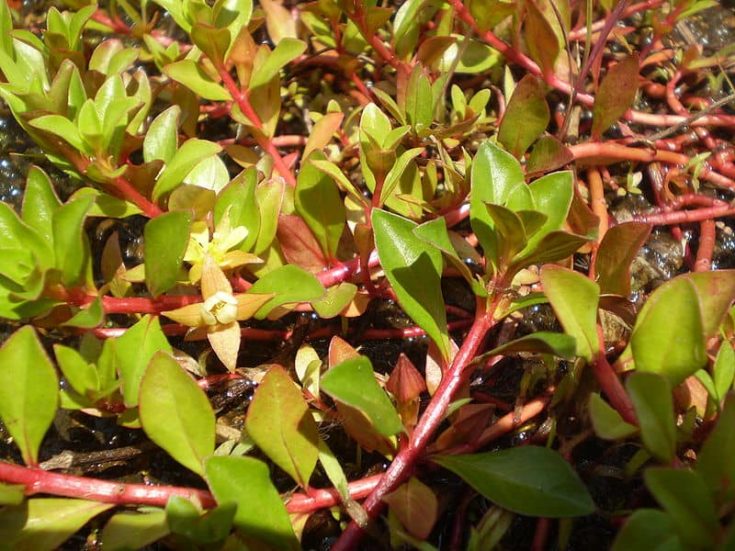
Scientific Name: Ludwigia repens
Growth Rate: Moderate
Lighting: Low to Moderate
Temperature: 60ºF – 75ºF
Creeping primrose-willow is an Amazonian plant grown for its red and green leaves. Its leaves are long and narrow, with a point at the tip and a light green underside. Unlike other “petite” plants on this list, Ludwigia repens is a fast-growing stem plant that can clog up your tank’s filtration system if allowed to grow too quickly.
Every tall stem plant needs frequent pruning, and the ludwigia repens are no different. It should be pruned once a week with small scissors to prevent it from growing too tall. If you’re looking for a different look, this is also an excellent choice if you want to create “carpets” along the front or side of your tank.
To ensure that ludwigia repens grows healthy and fast, you will need to add extra iron supplements into your tank’s water. They require a lot of iron to grow properly and cannot survive without it. In addition, Creeping primrose-willows can tolerate a slightly alkaline water condition if kept in hard water (above 8.0 on the pH scale).
Water Wisteria

Scientific Name: Hygrophila difformis
Growth Rate: Moderate to Fast
Lighting: High to Very High
Temperature: 70ºF – 85ºF
Water wisteria is a popular aquarium plant for beginners that not only looks stunning but also grows very quickly. It has long, tube-like leaves that grow along the water’s surface and will readily attach to your tank’s hardscape through short roots. This hardy specimen can grow up to 36″ in height under the right conditions, so it should be used sparingly in smaller tanks or bowls.
For best results, place Water wisteria near your tank’s filter so it receives a constant delivery of nutrients. Aquarium conditions that feature frequent doses of aquarium fertilizer and CO2 supplements will promote the best results. Water wisteria is sensitive to water conditions, so it should be introduced into your tank slowly to avoid ammonia or high nitrate levels that can kill it off.
The versatility of water wisteria means that you can grow it floating on the surface of your water or attached to a piece of driftwood. If grown on a hardscape, it will wrap around rocks and logs for a stunning visual effect.
Elodea

Scientific Name: Elodea canadensis
Growth Rate: Moderate to Fast
Lighting: High to Very High
Temperature: 60ºF – 75ºF
Elodea is commonly known as “waterweed” because its leaves are very similar to the leaves of terrestrial plants. The waterweed grows quickly in most conditions and will attach itself to rocks, driftwood or gravel in your tank’s hardscape.
Elodea can additionally be used for aquariums that contain fish species that feed on aquatic vegetation, such as betta fish. Floating elodea in the surface of your water will give betta fish a place to graze while hiding them away from predatory tankmates.
As elodea grows, it will require regular pruning to maintain your preferred shape. Elodea can be pruned with scissors or by hand to prevent it from growing into the filter system of your aquarium. You should also remove any dying pieces of elodea as soon as you notice them so they don’t rot and introduce dangerous toxins into your water.
Conclusion
There you have it! 15 aquatic plants that will do just fine without any form of substrate. Some of these can be floated directly on the surface of your aquarium while others may need to be attached to a hardscape, but all of them will grow without any help from a planted tank substrate.
So, if you’ve been thinking of removing your tank’s substrate or switching to a bare tank with no gravel, opt for one of these plants! We promise you won’t regret your decision.
Did you find this article helpful? If you did, please share it with a friend and leave any comments, questions, or suggestions about this article in the comment section below. We’d love to hear from you!

Great Information!!